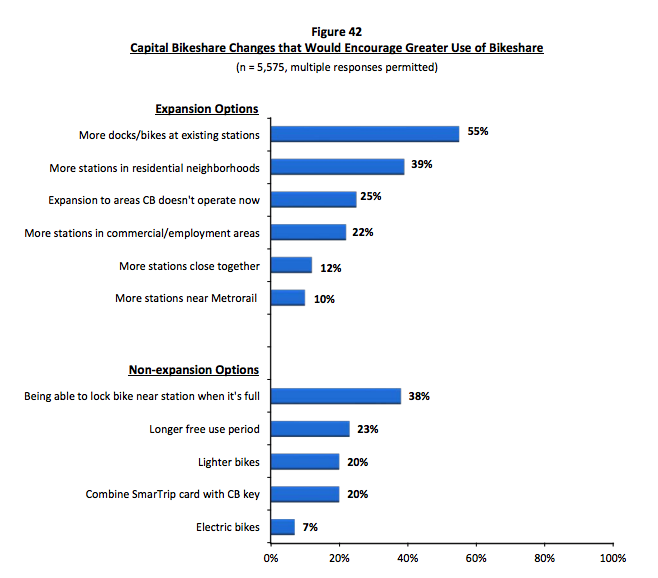For some, Capital Bikeshare remains the most convenient way to travel

Image by Stephanie Buck licensed under Creative Commons.
More than three-fourths of Capital Bikeshare members have a station within five blocks of their house, and about one-third started using the system more after Metro started SafeTrack. These numbers—and many other facts about CaBi users—come from CaBi’s most recent membership survey.
Since opening in September 2010, Capital Bikeshare has periodically surveyed its members to ask about who they are, why they ride, and how satisfied they are with the service. About 6,000 of CaBi’s 32,000 current members (18%) and 550 former members responded to the 2016 membership survey, conducted online during October and November of last year. CaBi did previous surveys in 2011, 2012, and 2014.
The 2016 survey provides a plethora of data on how the region’s biggest bikeshare network operates. Here are some of the survey’s most important and interesting findings:
People join and use Capital Bikeshare because it’s convenient
When asked what motivated them to join Bikeshare, nearly 90 percent of respondents cited the ability to get around more easily and quickly, which dwarfed other possible reasons like personal health or fitness, or concern about the environment. A majority of respondents also said the motivation for their most recent CaBi trip was that biking was the quickest or easiest way to make the trip. Members view Bikeshare as an extremely convenient way to travel.
It’s no surprise then, that for most members, a Bikeshare station is never far from home or work: 77 percent said they lived within five blocks of a station, and 86 percent had one within five blocks of their workplace. Naturally, with such short distances to stations, nearly all members access Bikeshare stations by walking.
Image by Capital Bikeshare.
Members use Bikeshare for both work and personal trips
When asked to list their top three types of trips them make with CaBi, respondents cited both work and personal trips as important to them. For example, about two-thirds of riders said commuting was a primary reason they use Bikeshare—surely no surprise to frequent users who see docks empty out rapidly in residential neighborhoods in the morning and fill up near offices. But nearly everyone (93%) also listed a non-work trip as a primary reason they use Bikeshare, and one-third of members said they only use Bikeshare for personal trips like visiting friends, traveling to personal appointments, or doing errands.
While the survey didn’t ask about when members made personal trips, I suspect many of these trips are during evenings or weekends when other modes, especially transit, tend to be less available or convenient.
There’s a wide range when it comes to how often CaBi members use the system
Image by Capital Bikeshare.
Pick any five Bikeshare members and ask them how often each uses the service and you’re liable to get five very different answers. One probably uses Bikeshare sparingly, at most once or twice a month, while another probably averages more than a trip a day. There’s no dominant pattern of use.
Instead, members have a wide array of usage patterns that likely reflects the inherent flexibility and convenience of Bikeshare: with an always-available fleet, members have the freedom to choose Bikeshare exactly as often as it makes sense for them.
One-third of members increased Bikeshare use because of SafeTrack
Bikeshare’s 2016 survey added a question about WMATA’s SafeTrack program to see if it affected member’s use of CaBi. The survey found about one-third of respondents said they used Bikeshare more often because of SafeTrack, evidence that Bikeshare can provide some folks with important travel flexibility during Metro closures.
Throughout SafeTrack, CaBi has added extra docks near Metro stations, and WAMU's Martin DiCaro noted in an article on the program's impact that “during the ninth SafeTrack project, a 25-day shutdown of the Red Line from Fort Totten to NoMa, casual and registered users logged 350,000 bikeshare trips, a significant jump from the previous week (50,000 trips).”
It is, however, important to remember that as a 3,700-bike system, Bikeshare’s ability to pick up the slack of cuts to Metrorail service is limited.
Users want more docks and more flexibility
Image by Capital Bikeshare.
The survey also asked members what expansion or non-expansion service enhancements would make them use Bikeshare more. Consistent with prior-year surveys, the leading “expansion” option was for more docks and bikes to be added at existing stations—a long-hoped for potential cure for the dreaded scourge of empty/full stations at peak times. Lots of members think another possible solution would be the ability to lock a Bikeshare bike up near a station when docks are full. Other suggestions are also aimed at further convenience, such as a longer free-use period or enabling a SmarTrip card to be used as a Bikeshare key.
Want to bike more? Join Bikeshare
An amazing 82 percent of respondents said they bike “more often” or “much more often” since joining Bikeshare. Any jurisdiction or neighborhood looking for a way to encourage more cycling in their community would do well to petition for a Bikeshare station or two in their area.
Interested in more detail? There’s plenty more in the full report. Feel free to share anything that interests you in the comments below.
